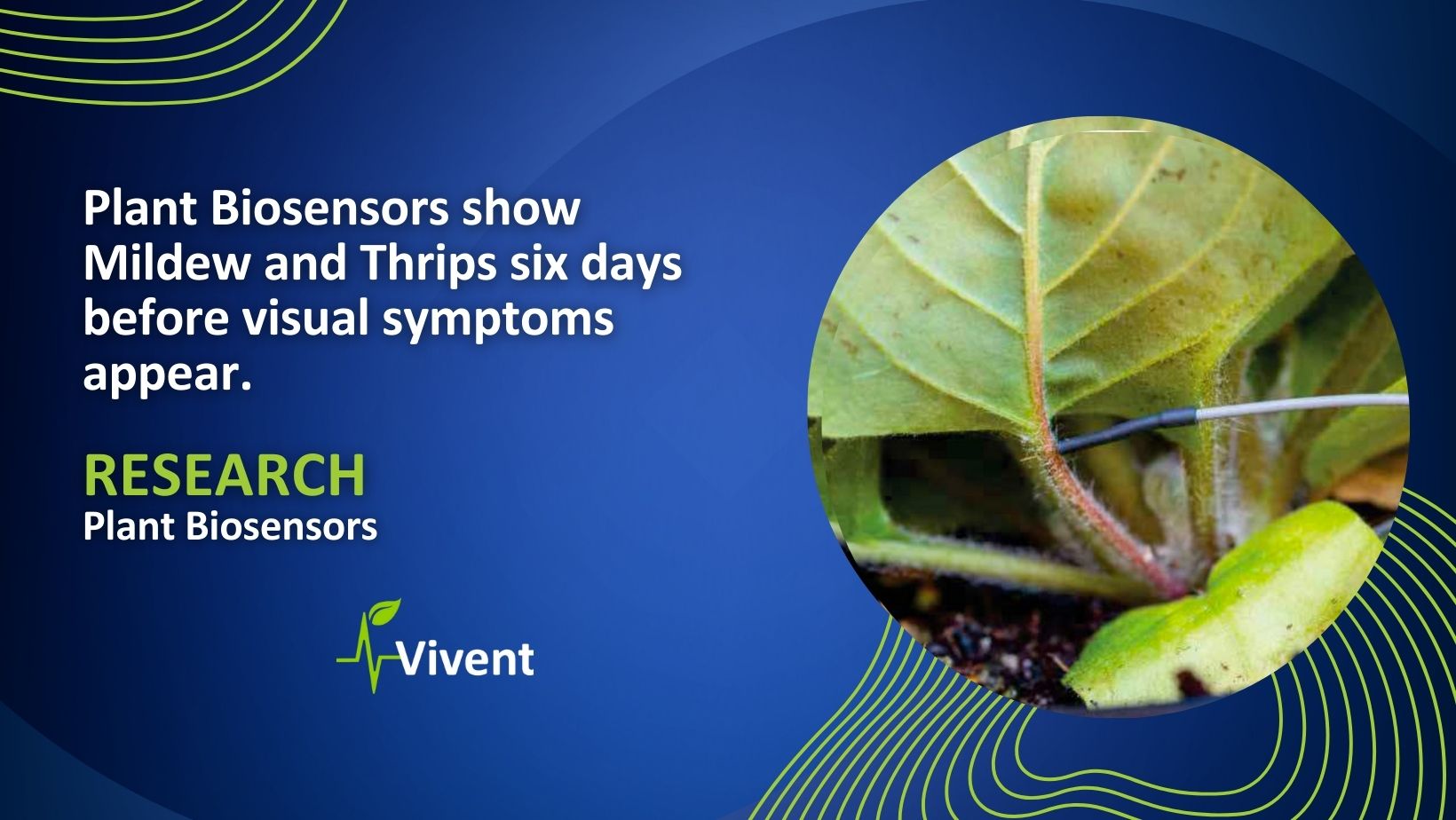

In Greenhouses | October 25th, 2023
Pests and diseases can place a crop under severe pressure. To limit the damage, these stress factors must be identified and controlled at the earliest possible stage. Unfortunately, the first symptoms are often only visible several days after the insect, fungus or other pathogen has struck, which is too late. However, the plant actually signals an attack much earlier, so the skill is to be able to recognise those signals.
Kirsten Leiss, plant health researcher at Wageningen University & Research in the Netherlands, is overseeing a two-year study looking into whether electrophysiological sensors can recognise biotic stress in plants. In particular, she wants to ascertain whether the individual stress signals can be associated with specific pests and diseases.
“How great would it be if a grower could find out exactly which pest or disease is affecting their crop before the symptoms can be seen with the naked eye? That would give them a significant advantage.”
Early pest detection
It’s just the same as with our nerve cells, the researcher continues. When you stimulate a plant, the electrical potential changes and an impulse is transmitted. “And that’s something we can measure.” Leiss expects that each stimulus will evoke a different electro- physiological reaction in the plant. “If we can recognise the stimulus for each signal, we can link the appropriate control measures to it – faster and more efficiently than we can at the moment.” She gives a thrips infestation as an example. A grower or crop worker will only realise there is thrips damage when they see its characteristic silvery sheen. “Keep in mind that symptoms only become visible after five to six days, and then only after a very thorough inspection of the leaves. An electrophysiological sensor, on the other hand, immediately measures a change in the electron flow when the plant is attacked. This happens as early as two days after the insect is introduced.” Armed with this knowledge, we can then act more quickly. It will help growers to protect their crops and yields, and nurseries and propagation companies to deliver a clean product.
Baseline measurements
Leiss chose two crops to identify the stress signals: tomato and gerbera. The companies involved – Koppert Biological Systems, Florensis, Valto Biocontrol, Syngenta Flowers, PlantoSys and Agrifirm-GMN – recommended three main plant health problems to infect the plants with: powdery mildew, thrips and cucumber mosaic virus. The first two weeks of each test were all about the baseline measurements. “Before we could start working with the harmful organisms, we had to establish a ‘baseline’ for each species. How does a clean crop respond to the normal stimuli present in the trial environment? You need to know that situation before you can observe any changes.”
For this purpose, the gerbera and tomato plants were successively connected to the sensors. These flawlessly recorded every electrophysiological signal emitted by the plants. Software from Vivent then converted this data into a baseline for each species and organism. “It worked well,” Leiss adds.
Filtering out the right signal
After the two baseline weeks the researchers added a standardised quantity of harmful organisms to a group of plants. Then they waited to see when and if the sensors would detect a stimulus. “To make sure this stimulus was caused by the disease or pest in question, we simultaneously monitored a non-infected control group . After all, the sensors are extremely sensitive: besides biotic stress, they also pick up abiotic stimuli. We could literally see every variation in watering or sudden temperature change in the data, for example.” The main task for the researchers, therefore, was to detect the right signal. In other words, what stimulus was caused by the infection and not by something else?

Kirsten Leiss (left) and Floortje Tilli: “It’s still a tangle of wires at the moment, but wireless sensors are on the way.”
Signal consistent with infestation

With mildew the plant raised the alarm after four days, while visual symptoms only appeared after ten days.
That observation was unmistakeable. In the case of mildew, the plant raised the alarm after four to five days. Visual symptoms only appeared after ten days. The plants infected with thrips emitted a stress signal after just two days (the effects were visible after five to six days). The researchers read off a clear spike in the data in both cases. And because each experiment – host plant plus disease – was repeated at least twice with the same outcome, Leiss is confident in concluding that the signals they read off corresponded to infestation by the pests/diseases in question. At the same time, she notes that the research is still at an early stage. “These are just the initial results, only with these two crops and these two diseases. The more data we collect in the future, the better the reliability of the results will be and the easier it will be for us to home in on those values. This will ultimately enable us to trace an intercepted signal back to a particular infestation.” Armed with this information, a grower will be able to detect pests and diseases in their greenhouse earlier than with regular visual scouting.
Data-driven cultivation system
The researcher is optimistic: “The results are promising. With these types of measurements we can boost the use of artificial intelligance. This fits perfectly with current developments in horticulture: data-driven systems that can control and optimise crops autonomously using sensors and automation.” This year the research team is focusing on experiments with virus infestation. The expectation is that the tomato and gerbera plants will also respond to this stimulus. “This would be a great starting point for further research, as there are still a huge number of plant responses to identify.” This two-year study is focused solely on plant responses caused by “live” stimuli, but a stress sensor can also register signals caused by other factors such as climate, light and irrigation. “If we were able to recognize all these influences, we could read the crop in real time. But before we get there, we need to collect and interpret a huge amount of data.”
Wireless Sensor
In parallel with data collection, we will need to make the sensor system more user- friendly. Leiss’s colleague Floortje Tilli points towards the three grow benches where the current trial has been set up. “Look: each sensor has eight channels and can therefore track eight plants. There are two electrodes attached to one plant on each input. So you’re talking about sixteen wires per unit – that’s quite a tangle of wires!” This makes life difficult during crop work and – for now, at least – makes it relatively costly to install throughout an entire greenhouse. But that, too, is being worked on, the researcher says. Leiss: “The manufacturer is working on developing wireless sensors.” That develop- ment will certainly add to the potential of stress detection in plants. After al; it is quite predictable that this method will be rolled out further in the future.
The article is published in In Greenhouses October 2023.




